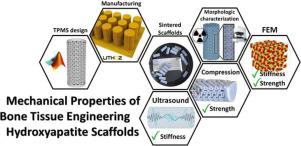Elastic and failure characterization of hydroxyapatite TPMS scaffolds using a combined approach of ultrasound, compression tests and micro-CT based numerical models
IF 8.3
1区 材料科学
Q1 MATERIALS SCIENCE, MULTIDISCIPLINARY
引用次数: 0
Abstract
Hydroxyapatite is a widely used ceramic material for bone tissue engineering. For creating suitable scaffolds, reliable design and thorough characterization are essential. In this study, we designed and 3D printed three Triply Periodic Minimal Surface (TPMS) scaffold geometries using Vat Photopolymerization (VPP). We employed a combined experimental and numerical analysis approach to evaluate printing accuracy and its correlation with the mechanical properties of the scaffolds. Our findings indicate that VPP can print complex micro-architectures as those of the TPMS with thin wall thickness in the range of few hundreds of micrometers. Ultrasound waves and compression tests were conducted to determine the effective stiffness and strength of scaffolds, respectively. Finite Element Models were developed based on Computed micro-Tomography acquisitions to simulate the experimental compression tests, showing strong alignment with the experimental data. Among the tested TPMS geometries, the Diamond microstructures fail with the lowest specific strength, while the highest specific strength is shown by the I-graph and wrapped package-graph (IWP) scaffolds.


求助全文
约1分钟内获得全文
求助全文
来源期刊

Acta Materialia
工程技术-材料科学:综合
CiteScore
16.10
自引率
8.50%
发文量
801
审稿时长
53 days
期刊介绍:
Acta Materialia serves as a platform for publishing full-length, original papers and commissioned overviews that contribute to a profound understanding of the correlation between the processing, structure, and properties of inorganic materials. The journal seeks papers with high impact potential or those that significantly propel the field forward. The scope includes the atomic and molecular arrangements, chemical and electronic structures, and microstructure of materials, focusing on their mechanical or functional behavior across all length scales, including nanostructures.
 求助内容:
求助内容: 应助结果提醒方式:
应助结果提醒方式:


